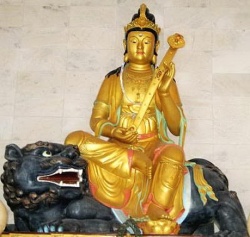Difference between revisions of "Theravada school"
| Line 4: | Line 4: | ||
[[上座部]] ([[Pali]]; Skt [[Sthaviravada]]; Jpn [[Joza-bu]]) | [[上座部]] ([[Pali]]; Skt [[Sthaviravada]]; Jpn [[Joza-bu]]) | ||
| − | "[[Teaching of the Elders]]." One of the two schools formed by the first [[schism]] in the [[Buddhist Order]] that took place about one hundred years after [[Shakyamuni's]] [[death]] in [[India]]. The other is the [[Mahasamghika]] school. According to The Great Commentary on the [[Abhidharma]], a dispute arose within the [[Buddhist Order]] over a five-point modification of [[doctrine]] advanced by a [[monk]] called [[Mahadeva]]. As a result, the [[Order]] split into the [[Theravada school]], which rejected the new interpretations, and the [[Mahasamghika school]], which accepted them. (Another account, however, [[attributes]] the [[schism]] to controversy over a more flexible interpretation of the [[precepts]] advocated by the [[monks]] of the [[Vriji]] tribe in [[Vaishali]].) Of the two schools, the [[Theravada school]] claimed a greater percentage of the elder [[monks]] and was more conservative, {{Wiki|emphasizing}} strict adherence to the established [[precepts]] and a literal interpretation of [[doctrine]]. According to The [[Doctrines of the Different Schools]] , the Sarva-stivada school, which developed the [[abhidharma]], or {{Wiki|exegetical}} commentary section of the [[canon]], later broke away from [[Theravada]]; under pressure from the [[Sarvastivadins]], the [[Theravada school]] moved to the [[Himalayan]] region where it was thereafter called the [[Haimavata]] ([[Himalaya]]) school. The [[Haimavata]] school later declined. The [[Theravada]] [[teaching]] was also introduced to [[Sri Lanka]] by [[King]] [[Ashoka]]'s son [[Mahendra]], where it developed and eventually spread to other parts of [[South]] and {{Wiki|Southeast Asia}}. What is called [[Theravada]], or Southern, [[Buddhism]], can be traced to these teachings introduced to [[Sri Lanka]]. See also [[five teachings of Mahadeva]]; [[ten unlawful revisions]]. | + | "[[Teaching of the Elders]]." One of the two schools formed by the first [[schism]] in the [[Buddhist Order]] that took place about one hundred years after [[Shakyamuni's]] [[death]] in [[India]]. The other is the [[Mahasamghika]] school. According to The [[Great Commentary]] on the [[Abhidharma]], a dispute arose within the [[Buddhist Order]] over a five-point modification of [[doctrine]] advanced by a [[monk]] called [[Mahadeva]]. As a result, the [[Order]] split into the [[Theravada school]], which rejected the new interpretations, and the [[Mahasamghika school]], which accepted them. (Another account, however, [[attributes]] the [[schism]] to controversy over a more flexible interpretation of the [[precepts]] advocated by the [[monks]] of the [[Vriji]] tribe in [[Vaishali]].) Of the two schools, the [[Theravada school]] claimed a greater percentage of the elder [[monks]] and was more conservative, {{Wiki|emphasizing}} strict adherence to the established [[precepts]] and a literal interpretation of [[doctrine]]. According to The [[Doctrines of the Different Schools]] , the Sarva-stivada school, which developed the [[abhidharma]], or {{Wiki|exegetical}} commentary section of the [[canon]], later broke away from [[Theravada]]; under pressure from the [[Sarvastivadins]], the [[Theravada school]] moved to the [[Himalayan]] region where it was thereafter called the [[Haimavata]] ([[Himalaya]]) school. The [[Haimavata]] school later declined. The [[Theravada]] [[teaching]] was also introduced to [[Sri Lanka]] by [[King]] [[Ashoka]]'s son [[Mahendra]], where it developed and eventually spread to other parts of [[South]] and {{Wiki|Southeast Asia}}. What is called [[Theravada]], or Southern, [[Buddhism]], can be traced to these teachings introduced to [[Sri Lanka]]. See also [[five teachings of Mahadeva]]; [[ten unlawful revisions]]. |
</poem> | </poem> | ||
{{R}} | {{R}} | ||
Latest revision as of 09:39, 24 February 2015
Theravada school
上座部 (Pali; Skt Sthaviravada; Jpn Joza-bu)
"Teaching of the Elders." One of the two schools formed by the first schism in the Buddhist Order that took place about one hundred years after Shakyamuni's death in India. The other is the Mahasamghika school. According to The Great Commentary on the Abhidharma, a dispute arose within the Buddhist Order over a five-point modification of doctrine advanced by a monk called Mahadeva. As a result, the Order split into the Theravada school, which rejected the new interpretations, and the Mahasamghika school, which accepted them. (Another account, however, attributes the schism to controversy over a more flexible interpretation of the precepts advocated by the monks of the Vriji tribe in Vaishali.) Of the two schools, the Theravada school claimed a greater percentage of the elder monks and was more conservative, emphasizing strict adherence to the established precepts and a literal interpretation of doctrine. According to The Doctrines of the Different Schools , the Sarva-stivada school, which developed the abhidharma, or exegetical commentary section of the canon, later broke away from Theravada; under pressure from the Sarvastivadins, the Theravada school moved to the Himalayan region where it was thereafter called the Haimavata (Himalaya) school. The Haimavata school later declined. The Theravada teaching was also introduced to Sri Lanka by King Ashoka's son Mahendra, where it developed and eventually spread to other parts of South and Southeast Asia. What is called Theravada, or Southern, Buddhism, can be traced to these teachings introduced to Sri Lanka. See also five teachings of Mahadeva; ten unlawful revisions.
